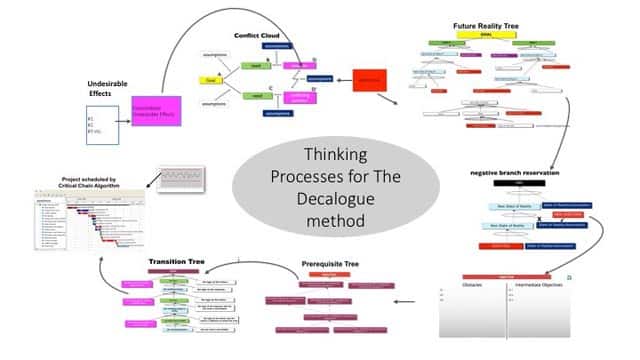Technology speeds everything up, including the world of technology itself. Digital transformation involves transformation of business activities, processes, competencies and models to fully leverage the changes and opportunities of digital technologies. It’s time to look at how to manage the process of change in a systemic way.
How can we achieve that? The Deming cycle of Plan, Do, Study, Act is an ongoing process of improvement and innovation that any organization needs to embrace to face complexity and remain competitive. The Thinking Processes from the Theory of Constraints provide a solid, systemic analysis and roadmap of what to change, what to change to, and how to make the change happen.
Why change? Because our reality hurts
When our reality is biting us, it’s a signal that we need to do something. The cycle of Thinking Processes we use with the Decalogue approach to managing change starts by listing the things that are hurting.
In the Theory of Constraints, these ‘symptoms’ are called Undesirable Effects (UDEs). We may have no desire to change, but the UDEs are a prompt that make us aware of a need to change. The Undesirable Effects we experience are the result of the network of relations we are part of and that naturally evolve, whether we like it or not. In network theory, these would be referred to as ’emergent properties.’
Thinking cause and effect
Though some people may try, it is ineffective to adopt a ‘whack-a-mole’ attitude to cope with our Undesirable Effects one at a time. The reason for this is that each Undesirable Effect is interconnected as a symptom of an underlying cause.
Whether we can do something about the cause or not doesn’t really matter. Either way, we need to change because that cause may in time severely limit our ability to achieve goals that are critical for us. That cause is what is blocking us from achieving more towards our goal. It becomes our constraint, and as Goldratt used to say, you can ignore the constraint, but it won’t ignore you. We need to learn to understand cause and effect, i.e. to recognize the effects we experience, and link them to their cause.
Goldratt created the Thinking Processes to fortify in people the ability to reason cause-and-effect. This is a daunting task because our mind simply does not work that way.
In our daily lives, most of the time we “re-act” instead of acting and we very rarely understand the full spectrum of the consequences of our “re-actions”. But change is something that can be achieved. We just need to understand that it is a process, and that process goes through various phases, or levels of resistance.
Level 1: Are we dealing with the right problem?
This is the deepest level of resistance. There is no common agreement about what the problem is that requires some form of change. To tackle this level, we must identify the cause of the majority of negative or undesirable effects that are being experienced. This can be done very effectively and quite fast through the method of the Core Conflict Cloud.
Level 2: Is the solution the right one?
Once there is agreement about what needs to be changed, there must be agreement about how the change will be implemented. The direction of the solution is found by identifying solutions (called “injections” in TOC) to the core conflict. This is done by invalidating the assumptions (mental models) that keep people stuck in the core conflict. It allows a shift towards a stage of agreement where it is no longer “you against me because of the problem” but “you and me against the problem”.
Level 3: Have we really thought everything through?
This level reflects a disconnect between the understanding of change required and the logic that will bring the results. A fully fleshed out solution needs to be mapped out. For this reason we build a Future Reality Tree. This process gathers together all the “injections” with a supporting logic to prove that the proposed changes will bring results. It also leads to identifying further injections that complete the solution. The result is a clear map that becomes a living document shared among those involved in the change process.
Level 4: Are bad things going to happen to me because of change?
People will be sensitive to possible negative implications they perceive for themselves through the implementation of the solution. It is important to identify negative implications early to:
- protect the proposed changes from unexpected difficulties;
- get buy-in from people who may tend to be nay-sayers;
- demonstrate leadership through an ability to listen to relevant objections and incorporate that feedback.
The Thinking Process for this is called Negative Branch Reservation.
Level 5: Aren’t there too many obstacles to make this work?
At this level, the solution is much closer to being accepted as a reality and people’s objections are at a very concrete level of obstacles in the way, often in the shape of a lack of resources.
The people who see the obstacles are often the very ones with the knowledge to tackle them. It is vital to be able to address and overcome these obstacles and the process for this is called an Intermediate Objective. All the necessary Intermediate Objectives (IO) can be mapped out on a Prerequisite Tree in a logical order of what needs to be done first before another IO can be achieved.
Level 6: Am I (and are others) really able/willing to do this?
After level 5 has been overcome, we are in a situation where all we need to do is take the actions to achieve the Intermediate Objectives. Even so, at this stage people may freeze. This may be simply because there is not enough clarity on tasks or because not all the objections have been raised. This is a critical phase in terms of leadership and can be greatly facilitated by giving and sharing clear instructions through the use of the Transition Tree.

The Human Constraint
Change is not just about doing things differently. It’s about thinking differently in order to make change possible. Many efforts to bring change fail because they do not address the cognitive challenge. This is what we have come to call the Human Constraint. When we educate ourselves to think and act systemically, we become capable of so much more than we imagine. As Einstein put it, “Those who think it’s not possible shouldn’t disturb those who are doing it.”
With this article, Domenico Lepore continues his mini-series of articles that focuses on how to build companies that are fit for the digital age. The next one will be the conclusion to this series.





















Add Comment